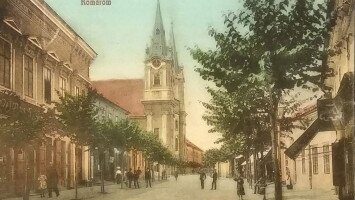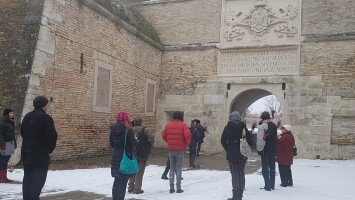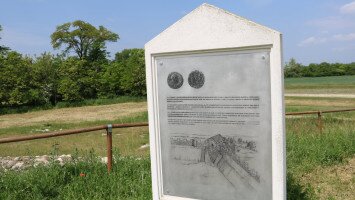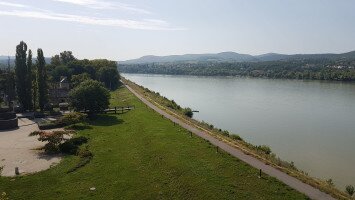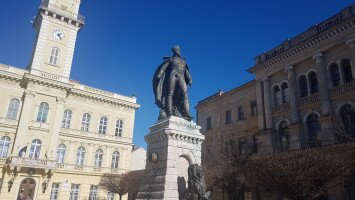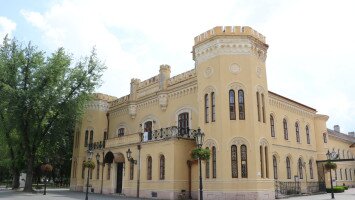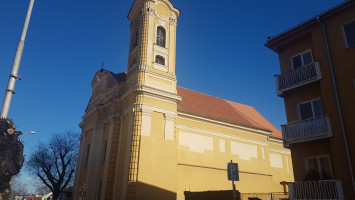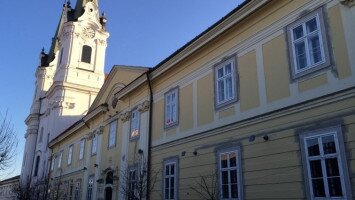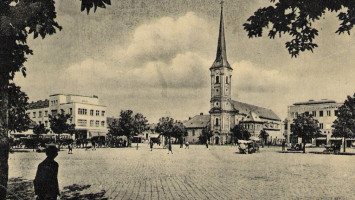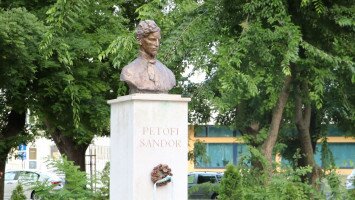
History of Iža
History
Iža is an important archaeological site. The name of the village is mentioned in 1172, 1268: Isa, 1291: Ysa, 1786: Isoha, 1808: Izsa. Two settlements belonged to Iža, from the south Harčáš (1397: Harchas) and from the east Bokroš (Bokros 1696). The area has been inhabited since the recent Stone Age. Rich finds testify to the settlement even in the Eneolithic period (ceramics and clay vessels). During the excavations, the North Pannonian burial ground, the remains of the Dacian culture were discovered and the Roman military camp was discovered. Right on the banks of the Danube are the remains of a Roman fortress. (second half of the 4th century AD) as well as a Slavic cemetery from the 9th century.
Antiquities
Archaeological finds in the Danube river basin prove that this area was inhabited as early as the Stone Age. An even more inhabited area became when at the end of the tenth millennium BC. the last ice age ended and the climate resembled today. People were looking for suitable areas for their livelihood, such as valleys in river basins, fertile fields, where they settled and gradually began to cultivate the land.
In the years 600 to 2900 BC. a newer stone age was created, which was visible in better and more precise processing of objects. In addition to hunting and fishing, they began to cultivate the land and raise animals, as a result of which they were tied to a certain area. This is how a form of agriculture was created. In a territory where they had favorable living conditions, they settled for a longer time. Even the excavations found indicate that there was an ancient agricultural area. In II. millennium BC they are beginning to learn about bronze production in Central Europe. In addition to farmers and shepherds, a layer of craftsmen was created. The exchange of goods expanded, the division of labor improved, and at the same time, property strata began to form among the people. In the later Bronze Age, a typical Danube culture emerged, which historians call "limestone inlaid pottery".
Representatives of the northern empire of the province of Pannonia cremated their dead, placed the ashes in ash buckets, and placed them in graves only 40-60 cm deep down the ground. In addition to ash buckets/urns/, they placed various other vessels in the tomb. These were of various sizes. There was also a tomb in which archaeologists found 40 vessels.
In the earlier Iron Age in years 700-400 BC. Thracian tribes came to this area from the eastern part of the Carpathian Basin. The center of their residence was Chotín, where archaeologists discovered an extensive burial ground. The Thracians dealt with the breeding of cattle, which grazed on the surrounding pastures. In the 4th century, BC Celtic tribes migrated to the territory of today's Danubian Lowland. Their arrival marked perhaps the greatest turnaround in ancient history. They conquered the local population in the occupied territory and for a time became the exclusive masters of today's territory of southern Slovakia. The culture they brought with them differed markedly from the Iron Age culture preserved by the people living here. Signs of a more developed southern culture, especially the Greek and Etruscan influences, were visible in this culture. They were masters of various crafts, mainly blacksmithing, glassmaking, and excelled in pottery and making hand mills. The development of handicrafts was ensured mainly by the invention of the smelting iron. In agriculture, they began with real tillage. The great development of trade occurred when the first to start minting coins in this territory and using them as currency for goods. They lived in tribes where the family played an important role.
The ruling class arose from a wealthier class, the aristocrats who knew how to control a highly differentiated Celtic society. Dwelling houses were built in settlements, rectangular in shape with dimensions of 3 x 5 meters. These were built below ground level. They buried the dead in their own way, along with decorative and utility objects.
At the turn of the last century BC, the Celts conquered the united tribes of the Dacians.
The territory of today's southwestern Slovakia in the 1st century AD inhabited by tribes of Germanic Marcomanni and Kvádov was located in the immediate vicinity of the Roman Empire. The natural northern border of the empire - the province of Pannonia was formed in this area by the river Danube, along which the Romans gradually built an extensive border fortification system called. LIMES ROMANUS, which consisted of military camps. It also included a military fortress in Iža.
From a cultural-historical point of view, one of the most important military camps in Slovakia is the Leányvár (Girl's Castle), which was named Celemantia by the ancient geographer Ptolemy.
An Ižan native, archaeologist Dr. János Tóth Kurucz, who with his ant work laid the foundations for further research. This important scientist died at the age of 91 and is buried in the cemetery in Dunaalmás in MR.
At the beginning of the 5th century, the Hun tribes came to the Carpathian Basin from Central Asia. Their barbaric invasion ravaged the Danube Plain. Their government ends in 459 death of King Attila, who suffered defeat on the territory of present-day France. They also had to leave the Danube region.
At the beginning of the 6th century, the Slavs began to populate the Carpathian Basin, settling mainly in the river basins and hills
In the second half of the 6th century (568) they came to the area of Avari. It was a fighting nation that conquered the left side of the Danube. Their burial grounds were discovered in the surrounding villages of Radvaň nad Dunajom, Žitava, and Virt. They found eight Avar cemeteries in Komárno. The Avars lived in tribes whose core consisted of members of one genus. They often threatened the Slavs. Their domination ends at the end of the 8th century when they suffered a fatal defeat by the Frankish ruler Karol Veľký (Charlemagne).
At the end of the 9th century (896), Hungarian tribes came to the Carpathian Basin and gradually populated this countryside. Their traces can be found in Nesvady, Marcellova, Chotín, Svätý Peter, Imel, Bátorové Kosihy, Zlatná na Ostrove and Zemianská Olča.
The dwellings created in the early feudalism were later used to establish larger settlements, the creation of towns and villages, especially in the 13th century when the greatest flourishing of feudalism followed.
Middle Ages and Modern Age
The first written report about the village comes from 1268 (according to the municipal chronicle), where the village is listed under the name Isa. In the same form, it is mentioned in the bulletin of Pope Innocent V, in which he mentions the deed of gift of King Bel IV. According to legend, King Matej Korvin also appeared among the fishermen from Iža. The king gave them privileges and exempted them from taxes. Pope Innocent V. was elected pope in 1276, but he headed the Catholic Church for only 5 months. In his bulletin, he praises Bela IV. and cites it as an example to other rulers for supporting the church. The feudal lord of the village in 1593 was Gáspár Somogyi, who sold his work to the Prepošt (praepositu - the chief) of Esztergom, Michal Novák.
150 years of Turkish rule also affected the village of Iža. The inhabitants hid from the Turks in the underground holes of the Kormoš plain near Bokroš.
In 1624 - Iža, a village was occupied by the Turks and was obliged to bring wood to Nové Zámky, and the local "captain" also demanded people to build a fortress. After the expulsion of the Turks in the village remained only 20 houses, the others were destroyed, looted. The population has also dropped significantly. There is a small bridge on the banks of the Danube near the gas station, which is said to have been built by the Turks. People called it the "Turkish bridge" and it is still located here today.
The year 1599 is important in the life of the village when the troops of the Transylvanian prince Štefan Bocskai swept through the village and completely destroyed the Roman Catholic church, which was probably built in the 16th century. Its restoration took place much later in 1721. Earthquakes in 1760 and 1773 damaged the church again. It was definitively restored in 1774. Its original vaulted ceiling was replaced by a flat, smooth one, so today's church does not have the original architectural character. The church is dedicated to Archangel Michael, who is the central figure of the altarpiece from 1883. The main altar and pulpit of the church date from the 70s of the 18th century, they are created in the Rococo style. The side altar is dedicated to St. Ján Nepomucký, probably dates from the 18th century. The building is a cultural monument.
Much younger is the Calvinist church built in 1871 in the late classical style. According to the book by Elek Fényes from In 1848, there were 1310 Catholics and 146 Reformates in the village. Catholics had mother churches and Calvinists had "daughter churches."
The second half of the 18th century brought further suffering to the inhabitants of the village. First in 1763, then 10 years later in In 1773, an earthquake devastated the village. Nevertheless, by the end of the 18th century, the number of houses had grown to 91 and the population to 823. In 1822, the village was again hit by a strong earthquake, after which only 16 undamaged houses remained. Iža was often threatened by floods and fires, which caused great damage to the population. The Great Flood was in 1895. The level of water in the flooded village is an inscription on a small table, which is located to the left of the entrance to the Roman-Catholic church.
On September 11, 1899, a fire broke out, which destroyed almost half of the village. A week later, the Danube got out of the riverbed and caused further damage to the citizens. Despite the mentioned natural disasters, the village gradually developed and the population grew. In 1900, they counted 2,055 people in Iža. The population was engaged in agriculture, fishing, some worked on the surrounding farms, or in industrial enterprises.
The oldest building in the village is a Roman Catholic parish. It stands in the middle of the village on the main road. The building has been home to many church figures for centuries.
In the 20th century, the village began to develop rapidly. One of the growing demands of the boom was the establishment of new streets. It came to this only after the strengthening of the Danube dam, because frequent floods forced people to build their houses on elevated places. Thus, the oldest street is Hlavná at an altitude of 113 m above sea level. The walls of houses were built of mud or hammered clay. Old traditional reed roofs have replaced tiles or shingles. Dwelling houses mostly consisted of three rooms. "First room" or "first house", then kitchen with open chimney, backroom ("back house"). They entered the front room only exceptionally. They cooked in the kitchen and heated the other rooms from there. In addition to living rooms, they also built farm buildings: storage room, stables, barns, shed, etc. Only the Hlavná (Main) street had a paved road, which since 1942 has been part of the state road to Komárno. The rainwater drainage was solved by our ancestors, for example, drainage ditches along the road.
In the First World War in 1914, there were summoned most of the young men to the front. War conditions ensued, and the church bell turned into a destructive weapon.
The war caused a lot of pain, not only at the front but also to the inhabitants outside the front. Many parents, wives, and children waited for the return of their loved ones (Many never came home). After the peace act in Paris in 1918-20, there were great changes in Central Europe. The Austro-Hungarian monarchy disintegrated, new states emerged, including Czechoslovakia. Our village became part of this state until 1938 when after the decision of Vienna, southern Slovakia became part of Hungary.
This period was a period of armaments, war camps and caused the spread of fascist sentiments. What people feared soon became a reality. WW II broke out. The men were mobilized again. Many of them did not survive the first military operation near Don. The war continued to take its victims. The air raids ravaged many homes and many people lost their lives.
In January 1945, the first Soviet soldiers came to the village. After the end of the war in Europe, changes took place again, and southern Slovakia was reunited with Czechoslovakia.
The present
After the war, the original inhabitants of the village could not participate in political and social life, because they did not have the civil right to associate, they also had suspended citizenship. The local people experienced hard days and months. Among other difficulties, they had to endure the fact of deportation. It was in December 1946 and January 1947. The displacement took place in the harsh winter and with the help of the army. People from the deepest social classes loaded the most necessary things on trucks and transported them from the Chotín railway station in cold wagons to the Czech Republic.
The deportations ended in the autumn of 1948, and affected families were able to return to their homes. In the spring of 1947, the inhabitants were forced to leave Iža in another direction. Under the interstate population exchange agreement, another, wealthier section of the population was relocated to Hungary. They could take all movable property. From the original inhabitants of the village, 148 families, about 445 people, moved to the county of Tolna to the south of Hungary.
They were replaced by resettlers who became friends with the locals in a relatively short time.
Today, the inhabitants of Iža are partly engaged in agriculture and partly in industrial activities.
